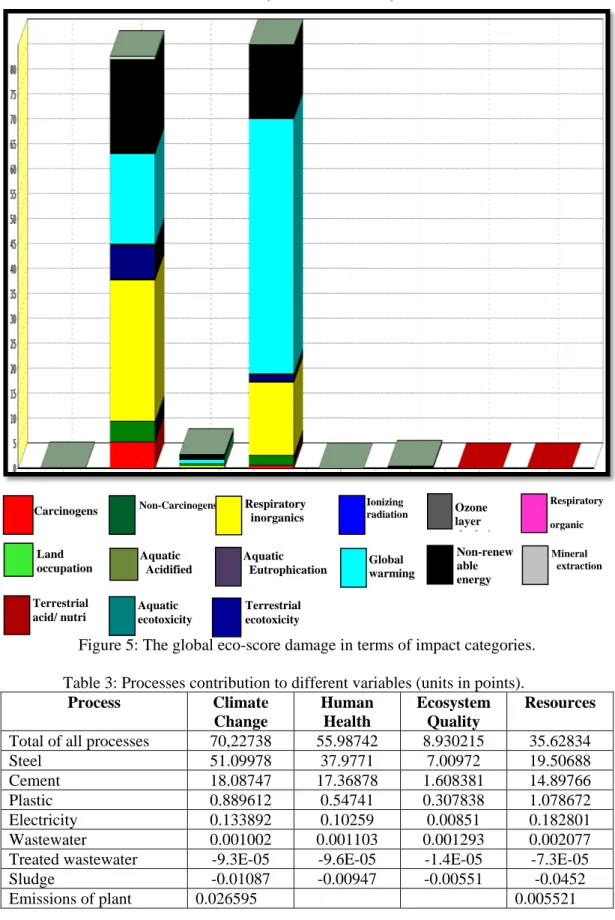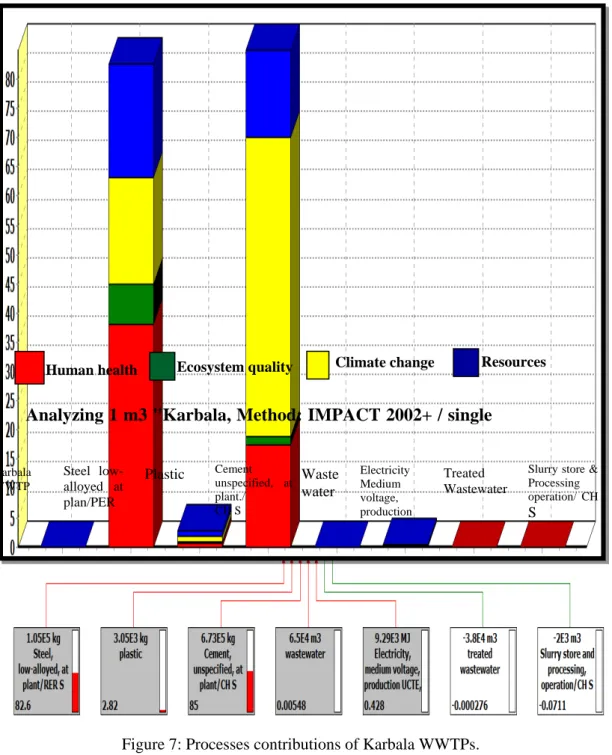Scienpress Ltd, 2014
Application of Simapro7 on Karbala Wastewater
Treatment Plant, Iraq
Mohammad A. Alanbari1, Nadhir Al-Ansari2, S. A.Altaee3 and Sven Knutsson4
Abstract
The use of treated wastewater is becoming more popular especially in countries suffering from water shortages despite the fact thatwastewater plants have some environmental implications. For this reason there are various software designed to do the assessment. Among these is SimaPro software package designed to make a valuable contribution. It is a powerful tool for analyzing the environmental impact to products during their whole life cycle. A huge amount of knowledge about the environment is built into the program and database, enabling to analyze a product with a minimum of specialized knowledge. In this study, Simapro was used to analyze and evaluate the impacts that result from Karbala Wastewater treatment plant. The results of Life Cycle Assessment (LCA) show that Karbala WWTP has an impact and damage on the environment of the order of 171 point for each 1 cubic meter of wastewater. The most environmental impacts potential were global warming, respiratory inorganics and non-renewable energy. The study also showed that most of the effects were as a result of the phase of construction more than of the operational phase.
Keywords: Life Cycle Assessment, Wastewater Treatment Plant, Karbala,SimaPro.
1 Introduction
Countries in the Middle East suffer from water shortages [1,2,3] and at least 12 Arab countries have acute water scarcity problems with less than 500 m3 of renewable water resources per capita available[4,5]. The supply of fresh potable water is essential to life, socioeconomic development, and political stability in the region. Scarcity of water resources in this region represents an extremely important factor in the stability and economic development within the region [1,6]. The largest consumer of water in the Middle East is agriculture which accounts for 66% of demand [7]. Therefore, the water shortage problem cannot be objectively analyzed nor adequately addressed without a thorough consideration of agriculture in the region [8]. An approximate 10 percent
1&3
Babylon University, Hillla, Iraq.
2&4
transfer of water away from agriculture would produce a 40 percent increase in domestic water supply for Jordan as an example [8]. Postel [9] argues that by importing the food/grain rather than diverting precious water to agriculture this water could be saved. This is not the case in many Middle Eastern countries which have unrealistic aspirations of food self-sufficiency and in it would require a most fundamental change in national outlook [10]. Sadik and Barghouti [8] emphasized that the extent of the problem is so severe that “the future challenges in meeting the growing demands for water are beyond the capabilities of individual countries”. Mitigating supply shortfalls could be achieved by re-allocation of current agricultural supplies [2].
One cubic meter of water can provide drinking water for one person for one year or the same quantity can produce only one kg of food grain when used for irrigation in a dry climate [11]. The need for a rationalized holistic management of this most vital natural resource is paramount in order to attain a sustainable society.
In addition to the above, the effect of climate change is expected to intensify the water shortage problem in the Middle East. The climate of the region contains hyper-arid, arid and semi-arid zones [12]. Several researchers concluded that arid and semi-arid regions are highly vulnerable to climate change (e.g. [13]). It is expected that the region will suffer from higher temperatures and intense heat waves affecting inhabitants and crop yields, and will also affect marine ecosystems and fisheries. Less but more intense rainfall, coupled with higher temperatures, will likely cause more droughts and greater flooding, sea level rise, more intense cyclones and new areas exposed to dengue, malaria, and other vector and waterborne diseases.
More shortages are expected in future [14,15,16] and depletion of groundwater resources [17,18]. Tigris and Euphrates Rivers will be completely dry by 2040 (UN, 2010). Due to the presence of the Rivers Tigris and Euphrates, Iraq was an exception till the 1970s [19,20].Al-Ansari [19] noted that construction of dams on the Tigris and Euphrates and their tributaries outside the border of Iraq, the effect of global climate change and mismanagement of water resources are the main factors in the water shortage problems in Iraq. Water required for restoring the marshes [21,22] and the growing demand for water in Turkey and Syria will lead to dry the Tigris and Euphrates Rivers in 2040 [23]. To overcome these problems in Iraq, there is a great need for prudent management of water resources and the adaptation of non- conventional techniques to augment water resources [19,20]. One of the non-conventional techniques that can be used to overcome water shortage is rain water harvesting and waste water treatment and re-use. In view of the above, most of the countries in the region are trying to minimize water allocated for agriculture using treated waste water. Using this technique however, has its own technical and environmental implications also. Iraq is one of the countries treating waste water simply to protect its environment and possibly using the treated water for other agricultural and/or industrial purposes when required.
Wastewater treatment capacity reaches 350,000 cubic meters per day and this serves 8% of the population where only 14 cities out of 252 urban centers have a wastewater treatment plant [24]. Waste water systems and drinking water networks are damaged and causing mix of water and as a result many people are infected by sewage related diseases [24,25,26,27].
The aim of the study is to appraise the impact of Karbala City Wastewater Treatment Plant (WWTP) on the environment by using environmental sustainability indicators. To achieve this aim, the existing information about Karbala WWTP was reviewed and the environmental sustainability indicators (ESIs) were identified.
2 Back Ground Information
Municipal wastewater utility managers have faced various difficult and complex challenges for many years. Some of the more recent and significant issues utilities are dealing with, include:
1- Making difficult decisions on capital improvement projects and staffing in tough economic times.
2- Dealing with the wide variety of bio-solids treatment technology and disposal options within the context of increasing public health concerns, reduced availability of land application sites, and rising disposal costs.
3- Increasingly stringent permit limits.
4- Water resource scarcity concerns and decisions to implement costly water reuse technologies and programs.
5- Rising energy costs and decisions to implement costly energy-related capital projects with long payback periods.
6- Risk and uncertainty related to budget constraints, costs, technology limitations, regulations, policy issues, and stakeholder concerns.
there has been increasing awareness, understanding, and acceptance by many utilities that their decisions and actions can have significant and lasting impacts beyond the boundaries of their respective service areas. This change in mindset had been largely due to the “sustainability movement” that has surged within the wastewater industry only within the past 5 years [28]. Life Cycle Assessment (LCA) was one of the sustainability tools, it was applied to analyze and assess the environmental impacts over the entire life cycle of wastewater treatment processes. Life-cycle assessment (LCA) had been found to be (i) a useful and promising technique which provides a holistic look at the environmental impacts of a product, process or activity, and (ii) an appropriate framework for environmental assessment. LCA studies had identified opportunities to improve environmental performance, by quantifying (a) the materials used, (b) the energy consumed, and (c) releases to the environment [29]. LCA is described in the ISO 14040:1997 series, namely by ISO 14041:1997 standard – Definition of objective, scope and inventory analysis, ISO14042:1997 standard – Environmental impact assessment and ISO 14043:1997 standard – Interpretation. SimaPro 7 software [30 was used for the inventory and database on resources consumption and environmental emissions in the present LCA. In SimaPro, the impacts of wastewater treatment plants are divided into four categories: ecosystem quality, human health, climate change and natural resources. SimaPro offers a vast database of environmental impacts associated with thousands of industrial processes and products [31].
3 3 Methodology
A. 3.1 Wastewater Treatment Plant (WWTP)
The plant was constructed in 1982 and located about 2.5 km south of Karbala city (Figure 1) in Al-Museir marshland with design capacity 50000 m3/day while the actual capacity was 65000 m3/day during period of study.Wastewater treatment project in the city of Karbala was designed to serve 165 000 citizens. The outflow is supposed to be suitable
for irrigation purposes. Karbala is one of the Muslims holy cities in Iraq and it is therefore expected that the city hosts many religious tourists during Religious events, which confirms the importance of securing the viability of the project to receive this extra load. The plant consists of the following units:
1-Screens: to separate the coarse floating substances. 2-Lift pumpng station: four pumps.
3-Grit chamber: to settle the grit and inorganic suspended solids. 4- Flow distribution chamber.
5-Primary sedimentation tank: two circular tanks (32 m in diameter) are used to remove
suspended solids that might pass through grit chamber used to collect excess sludge from secondary sedimentation tank. Wastewater is drained through the chamber to aeration tank and sludge is pumped to sludge storage tank for transferring it to the thickener.
6-Aeration tanks: the biological treatment is conducted by the means of conventional
activated sludge process with one aeration lagoons (52 × 25.8× 3) m, with eight mechanical aeration mixers, four along each side with power of 30 kW.
7-Secondary sedimentation tanks: two tanks, each one 63 m in diameter and 2 m depth.
8-Sludge pumping station 9- Collection chamber. 10-Thickener
11- Drying beds
12- Outlet at irrigation canal as. As shown in figure 2.
The specifications of influent and effluent of Karbala WWTP with effluent standards are given in table 1.
Figure 2: Flow chart of Karbala WWTP. (source: [32]).
Table 1: Treatment specifications of influent and effluent of Karbala WWTP (Volume of influent is 65000 cubic meter per day).
Indicator Effluent Effluent Standards
Volume (m3/day) 38000 pH 6.67 6.5 - 8 Temperature (°C) 22 35 BOD (mg/l) 78.75 40 COD (mg/l) 207.5 100 H2S (mg/l) 9.3 Nitrate (mg/l) ND 50 Phosphate (mg/l) 1.4 3 Sulphate (mg/l) 993.75 400 Chloride (mg/l) 247.25 600 T.S.S (mg/l) 77.5 60 O&G 68.75 4 NO2 0.66 3
Source: Karbala WWTP/Records/April 2010
B. 3.2 Simapro7 Methodology
SimaPro 7 is the computer software tool used to calculate and identify the pertinent environmental impacts associated with the sludge treatment technologies proposed in this study. It serves as a tool for managing and storing data, making calculations and
sensitivity tests. The LCA phases are structured in SimaPro in accordance with ISO14040 and ISO14044 LCA standards [33].
i. Goal and Scope definition in SimaPro
A special section is available for a description of the goal and scope for each project. There exist three sections and these include:
• Text fields into which a description of the different aspects of the goal and scope definition can be made. Text entered here can be later copied and pasted into the report [30]. The goals of this research are to analyze and to evaluate the environmental impacts of Karbala WWTP.
• Libraries section in which it is possible to predefine which libraries with standard data are considered relevant for the project to be run [30]. In this research, the library of ecoinvent system processes was selected.
• Data quality section where data characteristics can be predefined [30].
ii. Inventory Analysis
The inventory analysis involves parameters describing resources uses, material uses and emission to air and water. The assessment covers throughout the entire life cycle of the products or activities; construction; treating; sludge disposal; and all transportation involved.
An important goal of data collection is to establish a database which can be used on an ongoing basis for LCA. The data for a process must be collected in form, so called normalizing the process (Fig.3).
iii. Impact Assessment in SimaPro
There exist a wide variety of impact assessment methods available in SimaPro [33. In this study The IMPACT2002+ method was used to determine the environmental impacts of the treatment plant. Fig.4 shows the overall scheme of the IMPACT 2002+ framework, linking all types of LCI results via the 14 midpoint categories ( human toxicity ,respiratory effects, ionizing radiation, ozone layer depletion, photochemical oxidation, aquatic ecotoxicity, terrestrial ecotoxicity, terrestrial acidification/nitrification,aquatic acidification, aquatic eutrophication, land occupation, global warming, non-renewable energy and mineral extraction) to the damage categories (human health, ecosystem quality, climate change and resources)[34].
Figure 4: Overall scheme of the IMPACT 2002+ framework, linking LCI results via the midpoint categories to damage categories (Rolf.F,2007).
iv. Interpretations in SimaPro
This is designed as a checklist which covers the relevant issues mentioned in the ISO standards used. As suggested by PRé Consultants [30], observations are filled in when the LCA study is about to be completed and conclusions made.
4 Results and Discussion
The results of LCA were mostly not straightforward in favor of material design over the alternative one. Results of LCA had to be interpreted or weighted. The IMPACT2002+ methodology and LCA weighting method specially developed for product design. This method had proved to be a powerful tool for designers to aggregate LCA results into easily understandable and user-friendly numbers or units, the so called IMPACT 2002-IMPact Assessment of Chemical Toxics. The processes contributing to those impacts are detailed in the table 2.
Table 2: Impact factors according to various processes (units in points) (source:Simapro7[30]). Process Global warming Respiratory Inorganic Non-Renewable Energy Terrestrial Ecotoxicity
Carcinogens Non-carcinogens terrestrial acidification / nitrification Total of all processes 70.2 43.6 35.06597 7.709 5.877 6.203 0.612 Steel 18.1 28.4 18.95328 6.527 5.306 4.114 0.249 Cement 51.1 14.6 14.88956 1.174 0.540 2.087 0.349 Plastic 0.89 0.507 1.078 0.006 0.029 -0.0005 0.013 Electricity 0.134 0.0942 0.18278 0.006 0.001 0.003 0.0012 Wastewater 0.001 0.000746 0.002075 0.0001 0.0001 0.0001 1.13E-05 Treated wastewater
-9.26E-5 -7.19E-5 -7.2E-05 -1.2E-05 -1.1E-05 -1.2E-05 -9.5E-07
Sludge -0.0109 -0.00654 -0.04517 -0.00519 -0.0003 -0.0008 -9.8E-05 Emissions
of plant
0.0266 0.005521
Figure 5 shows the global eco-score damage in terms of impact categories for Karbala WWTP. The most environmental impacts potential were global warming, respiratory in organics, non-renewable energy, contributing to Karbala WWTP as follows: 70.2 pt global warming, 43.6 pt respiratory in organics and 35.1 pt non-renewable of total impact 171 pt. The processes contributing to that damage are detailed in the table 3.
Figure 5: The global eco-score damage in terms of impact categories.
Table 3: Processes contribution to different variables (units in points).
Process Climate Change Human Health Ecosystem Quality Resources
Total of all processes 70,22738 55.98742 8.930215 35.62834
Steel 51.09978 37.9771 7.00972 19.50688
Cement 18.08747 17.36878 1.608381 14.89766
Plastic 0.889612 0.54741 0.307838 1.078672
Electricity 0.133892 0.10259 0.00851 0.182801
Wastewater 0.001002 0.001103 0.001293 0.002077
Treated wastewater -9.3E-05 -9.6E-05 -1.4E-05 -7.3E-05
Sludge -0.01087 -0.00947 -0.00551 -0.0452 Emissions of plant 0.026595 0.005521 Global warming Carcinogens Non-Carcinogens Land occupation Aquatic Acidified Aquatic Eutrophication Respiratory inorganics Ionizing radiation Non-renew able energy Respiratory organic Mineral extraction Aquatic ecotoxicity Terrestrial ecotoxicity Terrestrial acid/ nutri Ozone layer d l ti
The damage categories were also analyzed by IMPACT 2002+. Four categories of damage were pointed out: Human Health, Ecosystem Quality, Climate Change and Resources (Fig.6). From fig.6 it can be identified that Karbala WWTP contributed 56, 8.93, 70.2 and 35.6 point to Human Health, Ecosystem Quality, climate change and Resources respectively.
The causes of all impacts and damages which mentioned previously were from construction phase of the plant (cement and steel) as shown in fig.7.
It was noted that cement is one of the most processes that contribute to the environment of several negative effects, followed by steel and then plastic, while the treated waste water and sludge have positive effects.
5 Conclusions
The IMPACT2002+ methods was one of methods in simapro7, it was applied to evaluate environmental indicators for Karbala WWTP in Iraq. The results indicated that the global eco-score on Karbala WWTP was171 Pt. The most environmental impact potential were global warming, respiratory in organics and non-renewable energy, as a result of cement and steel (construction phase), plastic using during chemical storing and pipes, electricity using for plant operation and emission of plant (Karbala WWTP).Environmental damage effect on human health, , climate change and resources were 56, 70.2 and 35.6 point respectively.
Fig.6. The global eco-score damage in terms of impact categories.
Figure 7: Processes contributions of Karbala WWTPs.
References
[1] Al-Ansari, N.A., Water Resources in the Arab countries: problems and possible solutions, Water: a looming crisis”, Intern. Conf. on World Water Resources at the beginning of the 21st century, UNESCO, Paris, 3-6 June 1998.
Ecosystem quality Resources
Human health Climate change
Analyzing 1 m3 "Karbala, Method: IMPACT 2002+ / single
Karbala WWTP Steel low- alloyed at plan/PER Plastic Cement unspecified, at plant./ CH S Waste water Electricity Medium voltage, production Treated Wastewater
Slurry store & Processing operation/ CH
[2] Rogers P. and Lydon P. (eds.), “Water in the Arab World”, Massachusetts, USA: Harvard University Press, 1994.
[3] Biswas A. K. (ed.), “International Waters of the Middle East– From Euphrates, Tigris to Nile”, Bombay, India: Oxford University Press, 1994.
[4] Cherfane C. C. and Kim S. E., Arab region and Western Asia, UNESCWA, in Managing Water under Uncertainty and Risk, UN World Water Development Report 4, Chapter 33, 2012.
[5] Barr J., Grego S., Hassan E., Niasse M., Rast W.and Talafré J., Regional challenges, global impacts, in Managing Water under Uncertainty and Risk, UN World Water Development Report 4, Chapter 7, 2012.
[6] Naff, T., Conflict and water use in the Middle East, , in Roger, R. and Lydon, P. (Ed.), Water in the Arab Word: Perspectives and Prognoses, Harvard University, 253-284,1993.
[7] Hiniker, M. Sustainable Solutions to Water Conflicts in the Jordan Valley, Geneva: Green Cross International, 1999.
[8] Sadik A.K. and Barghouti S., The water problems of the Arab world: Management of scarce water resources, In P. Rogers and P. Lydon (eds.), “Water in the Arab World”, Massachusetts, USA: Harvard University Press. 4-37, 1994.
[9] Postel S., Last Oasis – Facing Water Scarcity, New York: World watch Institute WW Norton & Co, 1992.
[10] Charrier B. and Curtin F., A vital paradigm shift to maintain habitability in the Middle East: the integrated management of international watercourses, In Water for peace in the Middle East and Southern Africa, Geneva: Green Cross International, 11-1, 2007.
[11] Perry J.C. and Bucknall J., “Water Resource Assessment in the Arab World: New Analytical Tools for New Challenges”, in N. J Jagannathan, A. S. Mohamed and A. Kremer (eds.), “Water in the Arab World: Management perspectives and Innovations”, World Bank, Middle East and North Africa Region, Washington, 2009.
[12] WRI, World Resources Institute, “Drylands, People, and Ecosystem Goods and Services: A Web-based Geo-spatial Analysis”, 2002. Available online at: http://www.wri.org
[13] IPCC (Intergovernmental Panel on Climate Change), “Climate change impacts, adaptation and vulnerability”, Cambridge University Press, Geneva, 2007.
[14] Bazzaz, F., Global climatic changes and its consequences for water availability in the Arab World, in Roger, R. and Lydon, P. (Ed.), Water in the Arab Word: Perspectives and Prognoses, Harvard University, 243- 252,1994.
[15] Al-Ansari, N.A., Salameh, E. and Al-Omari, I., Analysis of Rainfall in the Badia Region, Jordan, Al al-Bayt University Research paper No.1, 66p, 1999.
[16] Hamdy, A., Water Crisis and Food Security in the Arab World:The Future Challenges, accessed in 23 August 2013.
http://gwpmed.org/files/IWRM-Libya/Atef%20Hamdy%20AWC.pdf
[17] Chenoweth, J., Hadjinicolaou, P., Bruggeman, A., Lelieveld, J., Levin,Z., Lange, M., Xoplaki,E. and Hadjikakou1, M., Impact of climate change on the water resources of the eastern Mediterranean and Middle East region: Modeled 21st century changes and implications, J. Water Resources Res.,V. 47, W06506, 1-18,2011.
[18] Voss K., Famiglietti,J., Lo, M., de Linage, C., Rodell, M. and Swenson, S., Groundwater depletion in the Middle East from GRACE with implications for transboundary water management in the Tigris-Euphrates-Western Iran region, Water Resources Research, V.49, 904-914, 2013.
[19] Al-Ansari N.A., Management of Water Resources in Iraq: Perspectives and Prognoses, J. Engineering, V.5, 8, 667-68., 2013.
[20] Al-Ansari, N.A. and Knutsson, S., Toward Prudent management of Water Resources in Iraq, J. Advanced Science and Engineering Research, V. 1,53-67,2011.
[21] Al-Ansari, N.A., Knutsson, S. and Ali, A., Restoring the Garden of Eden, Iraq, J. Earth Science and Geotechnical Engineering, V. 2 , No. 1,53-88,2012.
[22] UN, Managing Change in the Marshlands: Iraq’s Critical Challenge, UN white paper,Report of the UN, 2011.
[23] UN, Water Resources Management White Paper, United Nations Assistance Mission for Iraq, United Nations Country Team in Iraq, 20 p,2010. http://iq.one.un.org/documents/100/white%20paper-eng_Small.pdf
[24] World Bank, Iraq: Country Water Resources, Assistance Strategy: Addressing Major Threats to People’s Livelihoods, Report no. 36297-IQ, 97p., 2006.
[25] MICS (Multiple Indicator Cluster Survey), IRAQ: Monitoring the situation of children and Women, Final Report, 2006.
http://www.childinfo.org/files/MICS3_Iraq_FinalReport_2006_eng.pdf
[26] UNICEF, Iraq watching briefs, Water and Environmental Sanitation, 64p. 2003. http://www.unicef.org/evaldatabase/files/Iraq_2003_Watching_Briefs.pdf
[27] Relief web, Water and sanitation in Iraq, 2003.
http://reliefweb.int/report/iraq/water-and-sanitation-iraq
[28] Steve T., Marco M., Achieving Sustainable Wastewater Treatment Through The Application of Life Cycle Management, 2009.
http://www.ncsafewater.org/Pics/Training/AnnualConference/AC09TechnicalPapers /AC09_Wastewater/WW_T.AM.08.30_Menendez.pdf
[29] Zhang Z. and Wilson F., Life-Cycle Assessment of a Sewage-Treatment Plant in South-East Asia, Water and Environment Journal, 14, 1, 51-56, 2007.
[30] PRé Consultants, Introduction to LCA with SimaPro 7, 2010. http://www. environmental-xpert.com/software/pre/pre.htm
[31] Leah F., Katya B. P.E. , Joyeeta B. P.E. , Tony G. P.E. , Sandeep M. P.E. , and Paul Pitt, P.E. , 21st Century Sustainability Metrics: An Introduction to Life Cycle Analysis, 21st Century Sustainability Metrics: An Introduction to Life Cycle Analysis. 2003.
http://www.ncsafewater.org/Pics/Training/AnnualConference/AC10TechnicalPapers /AC10_SpecialTopics/ST-M.PM_03.45_Bilyk.pdf
[32] Palmer, S. J., Karbala wastewater treatment plant, process description, Project No. 24910-602, Issue 1.0, March 2004, Bechtel International Systems, Inc., "Arabic",2004.
[33] Negelah S., A Life Cycle Assessment of Sewage Sludge Treatment Options. Msc, thesis, Aalborg University, Denmark, 2008.
[34] Rolf.F. and Niels. J., Implementation of Life Cycle Assessment Methods, Swiss Centre for Life Cycle Inventories, 2007.
http://modeleau.fsg.ulaval.ca/fileadmin/modeleau/documents/Publications/pvr967.p df
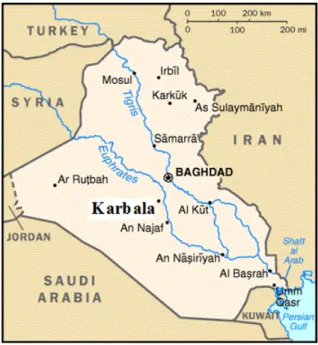
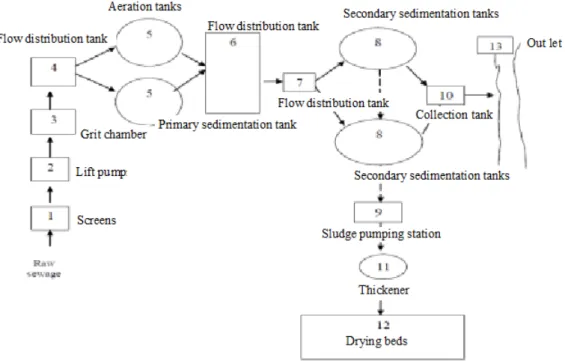
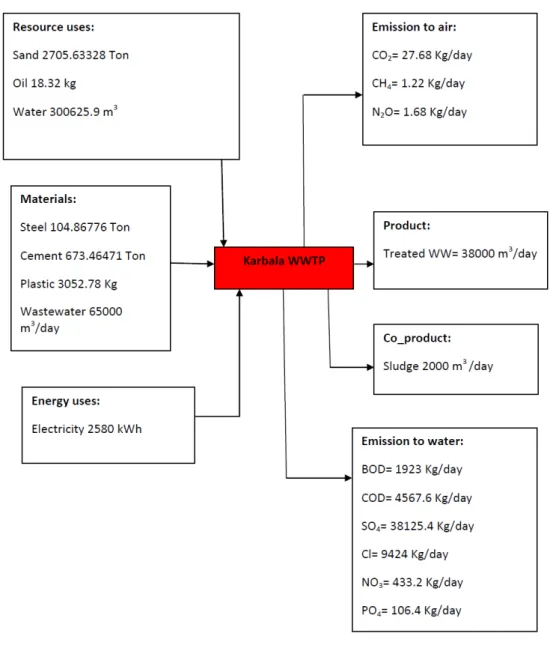
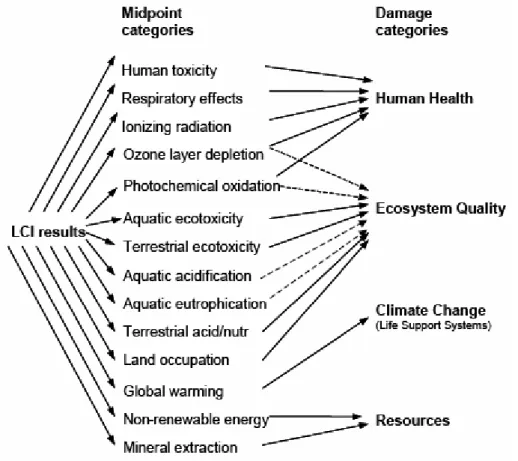
![Table 2: Impact factors according to various processes (units in points) (source:Simapro7[30])](https://thumb-eu.123doks.com/thumbv2/5dokorg/5501900.143288/9.812.101.710.144.470/table-impact-factors-according-various-processes-points-simapro.webp)
